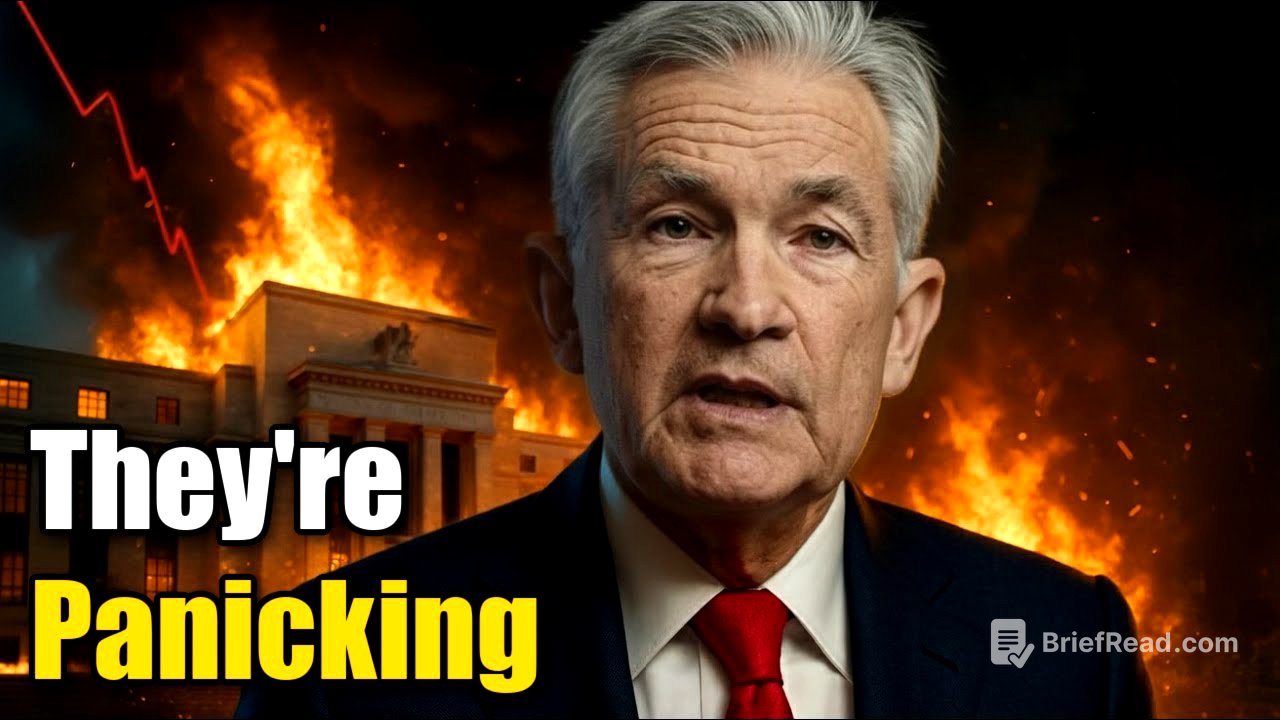TLDR;
The video discusses a potential liquidity crisis and dollar shortage brewing beneath the surface of the seemingly healthy stock market. It highlights warning signs in money markets, rising interbank lending rates, and increased usage of the Fed's standing repo facility. The speaker suggests the Fed's tools may be inadequate to address the situation, potentially leading to a significant dollar rally, market crash, and financial crisis. The video advises viewers to monitor the banking system, rotate portfolios into defensive positions, and consider hedging downside risk. It also features an update from Blackbox Stocks (BLBX) regarding their efforts to secure non-Chinese sources of rare earth elements.
- Money markets are flashing warnings, with banks turning to the Fed for overnight loans.
- Interbank lending rates are rising, indicating financial stress and a reluctance to lend.
- The Fed's standing repo facility is seeing increased usage, suggesting the Fed is acting as a lender of last resort.
- A potential dollar shortage could lead to a significant rally, market crash, and financial crisis.
- The speaker advises monitoring the banking system, rotating portfolios into defensive positions, and hedging downside risk.
Introduction: Liquidity Crisis and Dollar Shortage [0:00]
The video introduces the idea that a liquidity crisis and a massive dollar shortage are developing, despite the current stock market highs. These issues are largely unseen by the market but are signaling red alerts within Wall Street. The speaker warns that such liquidity crises have historically led to significant market downturns and suggests the Fed may soon declare an emergency but lack the necessary tools to effectively address it.
Warning Signs in Money Markets [0:56]
Money markets have been signaling warnings for weeks, suggesting that quantitative tightening (QT) may have run its course. Banks and money market funds are increasingly relying on the Fed for overnight loans, pledging treasuries and mortgage-backed securities as collateral. Simultaneously, money dealers are hesitant to lend, indicating tightening financial conditions and a growing scarcity of dollars. Various interest rates used by banks to borrow from each other have increased, and even the Fed's benchmark rate has ticked higher, signaling financial stress.
Banks' Reluctance to Lend and Dollar Shortage [1:50]
Banks are becoming increasingly reluctant to lend to each other due to concerns about potential bankruptcies and hidden risks on balance sheets, as highlighted by Jamie Dimon's comments. This reluctance is causing overnight lending rates to rise, indicating persistent money market tightness and a dollar shortage. The Fed's standing repo facility is experiencing increased usage, with the Fed acting as a lender of last resort. The speaker draws a parallel to September 2019, when similar conditions led to skyrocketing short-term rates, prompting the Fed to cut rates and implement quantitative easing (QE).
Potential Impact on Stock Market and Fed's Response [3:16]
Banks' need for cash is causing them to reduce risky lending activities. The Fed is keen to avoid margin calls, especially with $1.13 trillion in margin loans currently supporting stock prices. If the market ignores these risks and the Fed's tools prove ineffective, a further drying up of liquidity could force banks to sell assets, leading to a deep stock market contraction. To counter this, many large banks anticipate a 25 basis point rate cut and an end to QT at the next meeting.
Contrarian View on the Fed's Ability to Rescue the Market [4:07]
Wall Street is attempting to downplay the situation as a minor plumbing issue that can be easily resolved by ending QT. However, the speaker argues that the real risk is a dollar shortage that is too large for the Fed to manage. The government's demand for cash is outpacing the private sector's ability to generate it, leading to tightening financial conditions. The speaker highlights the 2-10 year Treasury yield curve as an indicator of imminent recession.
FOMC Meeting and Potential Outcomes [8:31]
The upcoming FOMC meeting is expected to result in a 25 basis point rate cut, with attention also focused on the potential end of QT and possible restart of QE. The speaker expresses concern that an abrupt halt to QT could spook equity markets and exacerbate the dollar shortage. The government's demand for cash is exceeding the private sector's capacity to meet it, as evidenced by the yield curve. The speaker believes the Fed's tools may be inadequate to address a massive dollar short squeeze, potentially triggering a crash in risk assets, a surge in the dollar, and a full-blown financial crisis.
Protecting Wealth and Portfolio Strategies [11:22]
To protect wealth, the speaker advises monitoring the banking system post-FOMC, rotating portfolios into defensive positions, and considering long dollar and long treasury positions. While holding onto other assets like tech stocks, crypto, and gold is acceptable, hedging downside risk is crucial. In the event of a crisis, having dollars will provide the opportunity to buy the dip.
Blackbox Stocks Update: Rare Earth Elements [12:01]
The video provides an update on Blackbox Stocks (BLBX), focusing on the rare earth supply chain. China dominates this market, controlling a significant portion of global mining and processing. Blackbox Stocks is merging with RE Alloys to secure non-Chinese sources of rare earth elements. RE Alloys has signed agreements for high-grade rare earth from Brazil and a long-term agreement for output from another company, along with strategic partnerships for tech transfers and investments to strengthen US and Japan supply chains.
